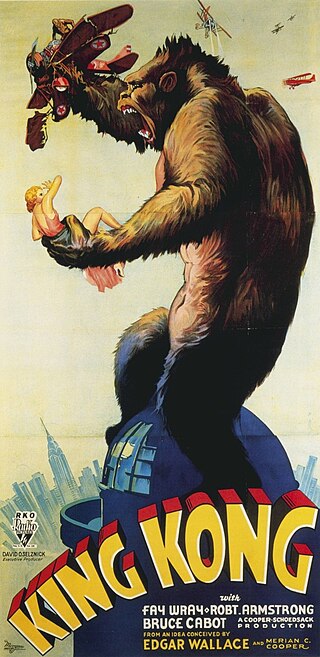
King Kong is a 1933 American pre-Code adventure horror monster film directed and produced by Merian C. Cooper and Ernest B. Schoedsack, with special effects by Willis H. O'Brien. Produced and distributed by RKO Radio Pictures, it is the first film in the King Kong franchise. The film stars Fay Wray, Robert Armstrong and Bruce Cabot. In the film, a giant ape dubbed King Kong captured from Skull Island attempts to possess a beautiful young woman.

Willis Harold O'Brien, known as Obie O'Brien, was an American motion picture special effects and stop-motion animation pioneer, who according to ASIFA-Hollywood "was responsible for some of the best-known images in cinema history," and is best remembered for his work on The Lost World (1925), King Kong (1933), The Last Days of Pompeii (1935) and Mighty Joe Young (1949), for which he won the 1950 Academy Award for Best Visual Effects.
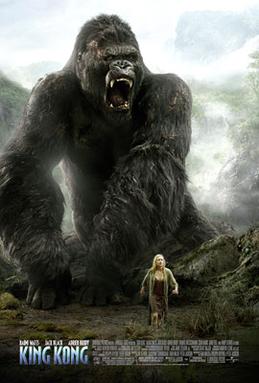
King Kong is a 2005 epic adventure monster film co-written, produced, and directed by Peter Jackson. It is the eighth entry in the King Kong franchise and the second remake of the 1933 film of the same title, following the 1976 film. The film stars Andy Serkis, Naomi Watts, Jack Black, and Adrien Brody. Set in 1933, it follows the story of an ambitious filmmaker who coerces his cast and hired ship crew to travel to mysterious Skull Island. There they encounter prehistoric creatures and a legendary giant gorilla known as Kong, whom they capture and take to New York City.

King Kong is a 1976 American monster adventure film produced by Dino De Laurentiis and directed by John Guillermin. It is a modernized remake of the 1933 film about a giant ape that is captured and taken to New York City for exhibition. It stars Jeff Bridges, Charles Grodin, and Jessica Lange in her first film role, and features mechanical effects by Carlo Rambaldi and makeup effects by Rick Baker who also played the title character. It is the fifth entry in the King Kong franchise.
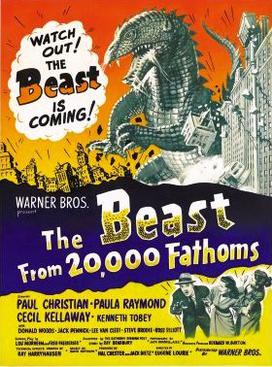
The Beast from 20,000 Fathoms is a 1953 American science fiction action horror film directed by Eugène Lourié, with special effects by Ray Harryhausen. The film stars Paul Christian, Paula Raymond, Cecil Kellaway, and Kenneth Tobey. The screenplay is based on Ray Bradbury's 1951 short story "The Fog Horn", specifically the scene where a lighthouse is destroyed by the title character. The film is about the Rhedosaurus, a dinosaur that is released from its frozen hibernating state by an atomic bomb test in the Arctic Circle and begins to wreak a path of destruction as it travels southward, eventually arriving at its ancient spawning grounds, which includes New York City.

The Valley of Gwangi is a 1969 American fantasy Western film produced by Charles H. Schneer and Ray Harryhausen, directed by Jim O'Connolly, written by William Bast, and starring James Franciscus, Richard Carlson, and Gila Golan.

The Mighty Kong is a 1998 American animated monster musical film. It is an adaptation of the classic King Kong story, produced by Lana Productions and is the 7th entry in the King Kong franchise. Jodi Benson and Dudley Moore headed its cast of voice actors. The film was animated overseas by the South Korean animation studios including Hahn Shin Corporation, and by Jade Animation in Hong Kong. It features original songs by the Sherman Brothers. The film was initially given a limited theatrical release before being released on VHS on June 16, 1998 by Warner Home Video as a part of their 75th Anniversary promotion. It was released on DVD by Tri-Coast Entertainment in 2019 as a Manufacture-on-Demand (MOD) release that is only available through online stores. The film is currently available on multiple streaming platforms such as Tubi and Vimeo.

King Kong, also referred to simply as Kong, is a fictional giant monster, or kaiju, resembling a gorilla, who has appeared in various media since 1933. Kong has been dubbed the King of the Beasts and over time it would also be bestowed the title of the Eighth Wonder of the World, a widely recognized expression within the franchise. His first appearance was in the novelization of the 1933 film King Kong from RKO Pictures, with the film premiering a little over two months later.
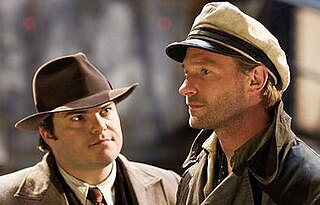
Carl Denham is a fictional character in the films King Kong and The Son of Kong, as well as in the 2005 remake of King Kong, and a 2004 illustrated novel titled Kong: King of Skull Island. The role was played by Robert Armstrong in the 1933 films and by Jack Black in the 2005 remake. In The Mighty Kong, he was voiced by Dudley Moore. Denham's function in the story is to initiate the action by bringing the characters to Skull Island, where they encounter the giant beast Kong. Denham then brings Kong to New York City to put him on display as entertainment, but he escapes and rampages through the city. The less faithful 1976 remake has an analogue character named Fred Wilson, portrayed by Charles Grodin.

Skull Island is the name most often used to describe a fictional island that first appeared in the 1933 film King Kong and later appearing in its sequels, the three remakes, and any other King Kong-based media. It is the home of the eponymous King Kong and several other species of creatures, mostly prehistoric and in some cases species that should have been extinct long before the rise of mammalian creatures, along with a primitive society of humans.

The Lost World is a 1925 American silent fantasy giant monster adventure film directed by Harry O. Hoyt and written by Marion Fairfax, adapted from Arthur Conan Doyle's 1912 novel of the same name.

Peter Jackson's King Kong: The Official Game of the Movie is a 2005 action-adventure video game developed by Ubisoft Montpellier and published by Ubisoft, based on the 2005 film King Kong. The game was created in collaboration between the film's director Peter Jackson and the game's director Michel Ancel. The game follows New York scriptwriter Jack Driscoll through Skull Island, as he attempts to save love interest Ann Darrow who has been sacrificed by the island's natives to the giant gorilla Kong.

King Kong, commonly referred to as The King Kong Show, is an American-Japanese animated series produced by Videocraft International and Toei Animation. ABC ran the series in the United States on Saturday mornings between September 10, 1966, and August 31, 1969. It is the first anime-based series produced in Japan for an American company.
Jack Driscoll is a fictional character in the King Kong franchise. In the original 1933 film he was the first mate of the ship named the Venture, while in its 2005 remake he was a playwright. He was played by Bruce Cabot in the original and by Adrien Brody in the remake. In both versions he is one of the main heroes of the story, a man who is on a ship heading for the mysterious Skull Island where Carl Denham intends to make a film. On the way, Driscoll falls in love with the actress Ann Darrow. When she is kidnapped by a giant ape named Kong on the island, Driscoll rescues her after helping to lead a search. Beyond these facts, his characterization is quite different in the two films.
Creation is an unfinished feature film, and a project of stop motion animator Willis O'Brien. It was about modern men encountering dinosaurs and other prehistoric animals on an island. The picture was scrapped by RKO studio head David O. Selznick on the grounds of expense, and Merian C. Cooper, the studio producer who recommended the film's cancellation, considered the storyline to be boring, due to lack of action. The completed footage ran 20 minutes in length, although approximately eleven minutes of footage is all that survives today. Cooper later used some of the miniatures and dinosaur armatures and O'Brien's stop-motion animation techniques for King Kong.
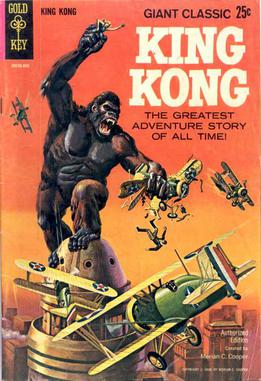
Throughout the decades King Kong has been featured in numerous comic book publications from numerous publishers.
King Kong is one of the best-known figures in cinema history. He and the series of films featuring him are frequently referenced in popular culture around the world. King Kong has achieved the stature of a pop-culture icon and modern myth. King Kong has inspired advertisements, cartoons, comic books, films, magazine covers, plays, poetry, political cartoons, short stories, television programmes, and other media. The forms of references to King Kong range from straight copies to parodies and humorous references.

King Kong is a musical with music by Marius de Vries, lyrics by Michael Mitnick and Craig Lucas, a book by Lucas and additional musical and lyrical contributions by 3D, Sarah McLachlan, Guy Garvey, Justice and The Avalanches. It is based on the 1933 film of the same name. The original production was mounted in Australia in 2013. A re-worked Broadway production premiered in October 2018.

King Kong is an American monster media franchise that consists of thirteen films, as well as television, novels, comic books, video games, attractions, and other merchandise. The franchise is centered on King Kong, a giant ape living on a primordial island inhabited by prehistoric creatures. The original film King Kong was co-directed by Merian C. Cooper and Ernest B. Schoedsack and was released on March 2, 1933; it was a box office success, despite opening during the Great Depression. The film's stop motion effects by Willis H. O'Brien revolutionized special effects, leaving a lasting impact on the film industry worldwide.
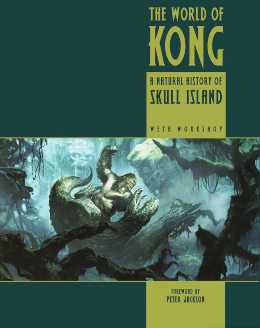
The World of Kong: A Natural History of Skull Island is a 2005 art book released as a tie-in to the film King Kong (2005). The book is written in the form of a field guide and natural history of the version of Skull Island and its creatures as presented in the film.

















